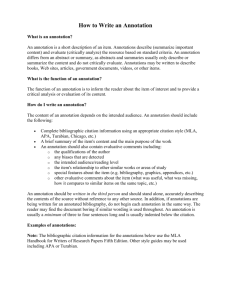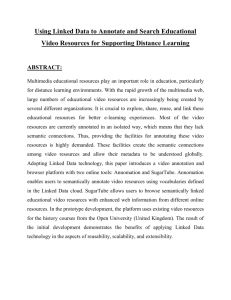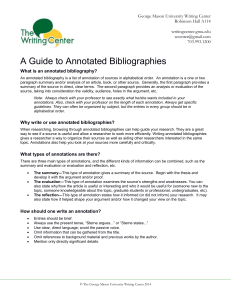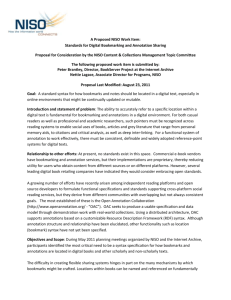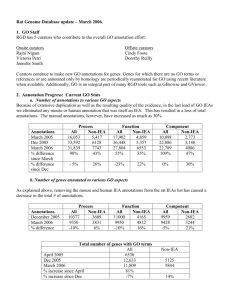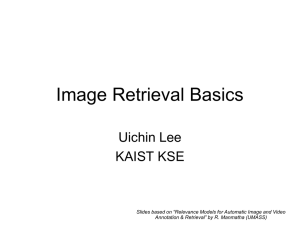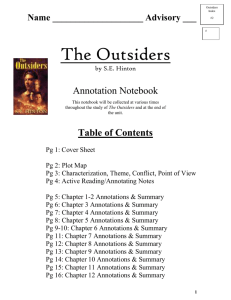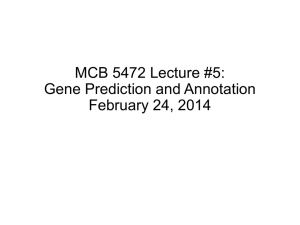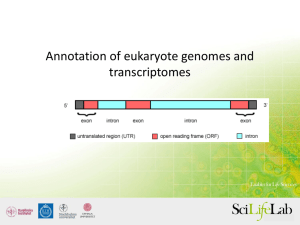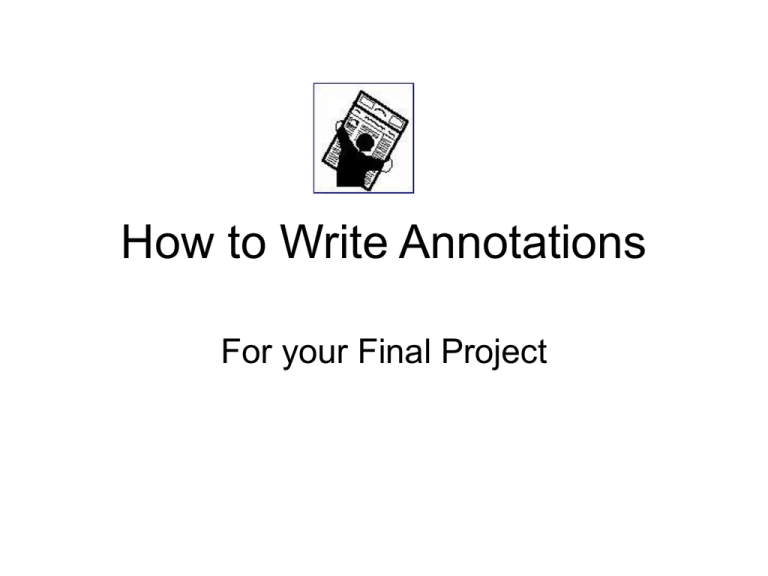
How to Write Annotations
For your Final Project
What is an Annotated
Bibliography?
• An annotated bibliography is a list of
citations to books, articles, and
documents.
• Each citation is followed by a brief (usually
less than 150 words) descriptive and
evaluative paragraph: the annotation.
• The purpose of the annotation is to inform
the reader of the relevance, accuracy, and
quality of the sources cited.
Annotations vs. Abstracts: the
Differences
• Abstracts are the purely descriptive
summaries often found at the beginning
of scholarly journal articles or in periodical
indexes.
• Annotations are descriptive and
critical; they expose the author's point of
view, clarity and appropriateness of
expression, and authority.
The Process
• First, locate and record citations to books, periodicals,
and documents that may contain useful information and
ideas on your topic.
• Examine and review the actual items, then choose those
works that provide a variety of perspectives on your
topic.
• Please note: you don’t need to read every source word
for word as you write your annotations for this classpractice scanning the contents.
• Cite each book, article or document using the
appropriate MLA or APA style.
• Write a concise annotation following each citation,
summarizing the central theme and scope of the book,
article or document.
How to Scan a Source
• Look at the table of contents
• Review the index
• Scan through each chapter reading
headings and captions
• Look for tables, graphs, charts and other
graphics
• Read the first few sentences and last few
sentences of each chapter
• Read through the introductory chapter
Annotation “Do's”
• Focus on the big picture, the main point or
purpose
• Put it into your own words
• Give the ideas of the source objectively
• Keep it concise: 2-3 sentences
Annotation “Don’ts”
• Don’t focus on specific details or
examples.
• Don’t copy the original wording.
• Don’t add new data or any of your own
ideas.
• Don’t include quotes from the source
material.
Start Your Annotation with a
Summary
• A summary briefly describes the contents of a source.
Scan or read the information quickly to determine its
main idea, argument or purpose. Then write a few
sentences of what it is about in your own words.
• Here is an easy way to begin a summary:
• In "[name of article]" [author] states . . . . [State the main
point of the article first.]
• For example: In “Computer Chess” Hans Berliner states
that the CYBER 170 series computer can perform well in
a chess tournament. (Example from the University of
Idaho Tech Writing Tutorial)
Evaluation Criteria: General Guidelines
Each annotation should include as many of the following
criteria as possible:
• Evaluate the authority or background of the author
• Comment on the intended audience
• Explain how this work illuminates your research topic
• Mention bibliographies, charts, graphs, statistics or
illustrations that are pertinent
• Discuss the writing style of the author
• Comment on any bias or point of view shown in the work
Specific Points for Evaluating Credibility and
Reliability
An evaluation of credibility focuses on the trustworthiness of the source. Locating
background about the author and/or publisher of the information is a good place to
start. Write a few sentences that express your judgment and opinions of the
author/publisher's background and the reliability of the source. Use these criteria for
reliability:
•
•
•
•
•
•
•
•
•
•
Author / Publisher
What are the credentials of the author? Are they experts in their field/ subject area?
Who is the publisher (may be an institution, company or organization) the author is
affiliated with?
Content Analysis
Purpose: Why was the author writing this?
Is there any bias in the information?
Is the information up to date? Does currency matter?
What audience is the information written for: lay person, scholarly, or a technical
audience?
Is it a broad overview or an in-depth examination of a topic?
How does the accuracy of the information compare to other sources?
Evaluate the Relevance of the Source
•
•
•
•
•
•
•
As you find information on your topic you need to review that
information in the context of your project and explain how it supports
your topic. Also consider the source in the context of the research
you have done and discuss how it compares to other sources.
How is the information is relevant to your project?
Does it give you an overview or background about your topic?
Are there statistics that help you prove a point?
Does the source support your argument or oppose it?
Is it written for the level of your audience?
Does it offer the right amount of detail?
After you have scanned and evaluated the information you must
decide if it is suitable for your needs.
Writing Tips
• Do not fill the space with generalizations
• Avoid such vague adjectives as "excellent" and
"good." Instead, use adjectives that
communicate something specific about the
source.
• Your summary should be brief… there is no
need to restate all of the information in the
source.
• Avoid beginning each annotation with "This
book..." or "This article..."
Examples of Good and Bad Annotations
(With thanks to Phyllis Usina)
The Good:
The main points of this article were
about the basics of fire fighting in the
modern world. It discusses how fire
fighters are dispatched to a call and
how they execute the steps for
extinguishing the fire. Encyclopedia
Britannica has been published for
many years and is used world wide to
find information on research projects.
This article helps me discuss the
basics of fire fighting today and how
the basics of fire fighting have stayed
the same throughout the generations.
The basics of fire fighting can be
broken down into four categories. The
four steps are protection, confinement,
ventilation, and extinguishment. The
fire fighting is a systematic process
which involves responding, accessing
and executing a call for a fire.
The Bad:
I used this book to get the basic
information about firefighting, it was
very informative.
More Examples of Good and Bad Annotations
The Good:
This article shows that children of
alcoholics and substance abuse
parents are associated with significant
medical and psychosocial problems.
Children of alcoholics (COAs) are
much more likely to abuse alcohol and
other drugs, and have higher rates of
anxiety, depression, poor academic
function, and antisocial personality
traits. I judged the credibility of this
source based on the fact that the
article was published in a scholarly
journal (the American Academy of
Pediatrics), and it contained a
bibliography of the sources used. The
information validates some of the
social and physiological factors that
influences children to alcohol abuse.
The Bad:
The article told me about children of
alcoholics. It was good.
More Examples of Good and Bad Annotations
The Good:
This web site has various links that
provide such things as the history of
Buddhism and the values and beliefs
in the Buddhism religion. The great
thing about the information provided in
this web site is that it is compiled by a
professor and the information is
geared toward someone with little or
no knowledge of the Buddhism Culture
and Religion. The information is from a
professor who also provides citations
from where he got his information. The
information is historical. This is a great
introductory to Buddhism website. It
has simple explanations to complex
ideas. I will be presenting this
information in class and the students
will have very little or no previous
knowledge on the topic. I think this
information will help me organize the
information in a logical way and that
makes sense.
The Bad:
I got all the facts I needed about
Buddhism and the different beliefs.
Degrees of Formality in Annotations
• Annotations can vary in style and have different
degrees of formality.
• More formal annotations avoid the first person
singular ("I"). When writing a formal annotation,
be especially careful not to begin each
annotation with "This book..." or
"This article..."
• For this class, you will be writing annotations in a
relatively informal style. First person singular is
acceptable. The previous examples show an
informal style of annotation. This is the style you
should aim for in your final project.
Example of a Formal Annotation
Goldschneider, F. K., L. J. Waite, and C. Witsberger. "Nonfamily Living
and the Erosion of Traditional Family Orientations Among Young
Adults." American Sociological Review 51(1986): 541-554.
The authors, researchers at the Rand Corporation and Brown
University, use data from the National Longitudinal Surveys of Young
Women and Young Men to test their hypothesis that non-family living
by young adults alters their attitudes, values, plans, and
expectations, moving them away from their belief in traditional sex
roles. They find their hypothesis strongly supported in young
females, while the effects were fewer in studies of young males.
Increasing the time away from parents before marrying increased
individualism, self-sufficiency, and changes in attitudes about
families.



